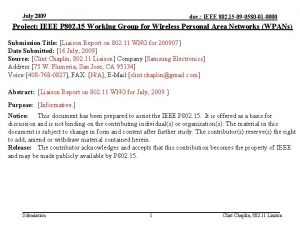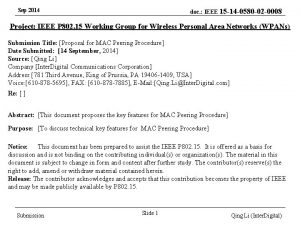July 2010 doc IEEE 802 15 10 0580



- Slides: 3

July 2010 doc. : IEEE 802. 15 -10 -0580 -00 -0006 Project: IEEE P 802. 15 Working Group for Wireless Personal Area Networks (WPANs) Submission Title: Proposal for TG 6 Comment S 9 -69 Resolution Date Submitted: 15 July, 2010 Source: Mark Dawkins, Alan Wong, Toumaz Ltd Re: Response to IEEE 802. 15. 6 Letter Ballot comments Abstract: This document proposes a resolution for Letter Ballot 55, comment S 9 -69, specifically for the Narrowband PHY section. Purpose: For discussion by IEEE 802. 15 TG 6 Notice: This document has been prepared to assist the IEEE P 802. 15. It is offered as a basis for discussion and is not binding on the contributing individual(s) or organization(s). The material in this document is subject to change in form and content after further study. The contributor(s) reserve(s) the right to add, amend or withdraw material contained herein. Release: The contributor acknowledges and accepts that this contribution becomes the property of IEEE and may be made publicly available by P 802. 15. Submission 1 Mark Dawkins and Alan Wong, Toumaz

July 2010 doc. : IEEE 802. 15 -10 -0580 -00 -0006 Sensitivity (1) • Comment(s): S 9 -69 – • Bluetooth LE), which could prevent low power designs. Better to define to a more relaxed sensitivity a) – 76 d. Bm for IEEE 802. 11 b 11 Mb/s CCK b) – 70 d. Bm for IEEE Std 802. 15. 1 -2002 c) – 75 d. Bm for IEEE 802. 15. 3 22 Mb/s DQPSK d) – 85 d. Bm for IEEE Std 802. 15. 4. ” Proposed Resolution: – – – • “The minimum receiver sensitivity is very strict for BAN (more tight than Zigbee and much more tight than Add additional margin to relax sensitivity requirements slightly Change text in section 9. 8. 1 lines 21 -23 to “The minimum input levels are measured at the antenna connector, where a noise figure of 13 d. B, which may include losses due to external components, and an implementation loss of 6 d. B have been assumed. ” Change minimum input levels (column 3) in Table 49 by increasing each value by 3 d. B (see next slide) Discussion: – Submission While we do not believe the sensitivity numbers should be made as relaxed as in the cases quoted in the comment, consideration of the terminology currently used in section 9. 8. 1 (namely “The minimum input levels are measured at the antenna connector, where a noise figure of 10 d. B (referenced at the antenna), an implementation loss of 6 d. B, and antenna gain of 0 d. Bi for both the transmitter and receiver have been assumed. ”) suggests that it is appropriate to include allowance for loss due to typical off chip matching/filtering components (which could be as high as 5 d. B). 2 Mark Dawkins and Alan Wong, Toumaz

July 2010 doc. : IEEE 802. 15 -10 -0580 -00 -0006 Sensitivity (2) Frequency Band (MHz) • The 10 d. B NF at present applies to the solution when measured at the antenna port 402 – 405 420 - 450 • If a SAW filter is used, this could imply a silicon NF of 6 d. B => Relax sensitivity by 3 d. B • Silicon design is eased and link margin is still >0 d. B in all cases even in 99% fade conditions 863 – 870 902 – 928 950 – 956 2360 - 2400 & 2400 2483. 5 Submission Information Data Rate Existing Sensitivity ~ link margin (d. B) (kbps) (d. Bm) 75. 9 -98 16 151. 8 -95 14 303. 6 -92 10 455. 4 -86 5 75. 9 -93 tbd 151. 8 -90 tbd 187. 5 -87 tbd 101. 2 -97 27 202. 4 -94 25 404. 8 -90 18 607. 1 -85 13 121. 4 -96 16 242. 9 -93 24 485. 7 -89 18 728. 6 -84 12 101. 2 -97 27 202. 4 -94 25 404. 8 -90 18 607. 1 -85 13 121. 4 -95 17 242. 9 -93 15 485. 7 -90 13 971. 4 -86 7 3 New sensitivity (d. Bm) -95 -92 -89 -83 -90 -87 -84 -91 -87 -82 -93 -90 -86 -81 -94 -91 -87 -82 -90 -87 -83 Mark Dawkins and Alan Wong, Toumaz





